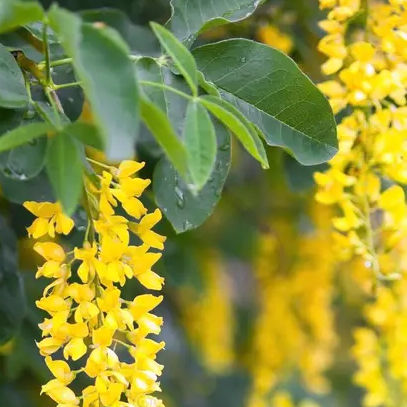Laburnum plants, also known as golden chain or golden rain, are ornamental trees and shrubs that belong to the genus Laburnum in the Fabaceae family. They are primarily grown for their attractive flowers and ornamental value in gardens and landscapes. However, it's essential to note that all parts of the laburnum plant, especially the seeds, contain toxic compounds (alkaloids), and caution should be exercised when handling or planting them, particularly in areas frequented by children or pets.
Here are some uses and qualities of laburnum plants:
- Ornamental Purposes: Laburnum plants are primarily cultivated for their beautiful, drooping clusters of bright yellow flowers. These flowers add a striking visual appeal to gardens and landscapes, making them popular choices for ornamental planting.
- Landscape Aesthetics: Laburnum trees, with their pendulous flowers and lush green foliage, are often used as focal points in landscape design. They can provide an eye-catching display when in full bloom, especially in spring.
- Arches and Pergolas: Laburnum's graceful, cascading branches make them suitable for training over arches, pergolas, or trellises, creating stunning garden features and providing shade.
- Attracts Pollinators: The abundant flowers of laburnum attract various pollinators, such as bees and butterflies, contributing to the overall biodiversity of the garden.
- Low Maintenance: Once established, laburnum plants generally require minimal maintenance, making them suitable for gardeners seeking low-effort ornamental options.
- Tolerant of Poor Soils: Laburnums can tolerate a range of soil conditions, including less fertile or sandy soils, as long as they are well-draining.
Qualities:
- Aesthetic Appeal: The most prominent feature of laburnum plants is their stunning display of golden yellow flowers, which adds a splash of color to any landscape.
- Deciduous Habit: Laburnum trees are deciduous, shedding their leaves in the fall, which can allow more sunlight to penetrate the garden during the winter months.
- Shape and Size: Depending on the species and cultivar, laburnum plants can grow as small trees or shrubs, offering flexibility in terms of the space they occupy.
- Adaptability: Laburnums are generally hardy and adaptable plants, able to thrive in a variety of climate conditions, although they prefer full sun.
It's important to reiterate the toxicity of laburnum plants, especially their seeds, which resemble small beans. Ingestion of any part of the plant can cause severe poisoning and even be fatal. Therefore, if you choose to grow laburnum plants, take necessary precautions, such as planting them in areas inaccessible to children and pets, and be cautious when handling them.

